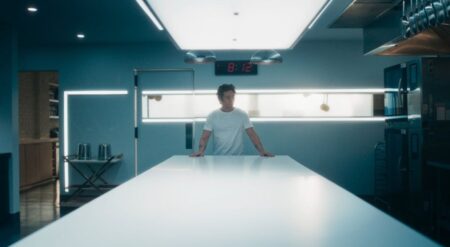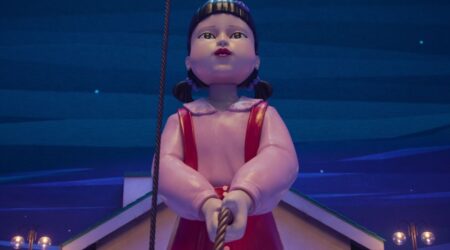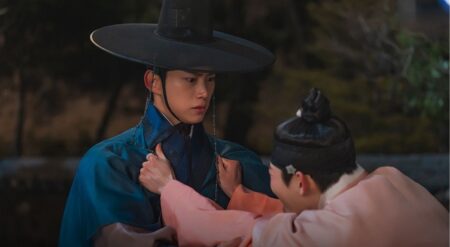
I don’t know where to begin. In my review of Selena: The Series Part 1 I mapped out how much Selena Quintanilla impacted my life and my identity as Chicana, and ultimately how Part 1 took the strongest parts of Selena (Christian Serratos) and made her docile and beholden to the men in her life. Now, with Selena: The Series Part 2 we see the second half of Selena’s story beginning with her eloping with Chris Perez (Jesse Posey), her beginning of a solo English career, and ultimately her death. The series is created by Moisés Zamora and is one of the very very few Latinx-led series on Netflix. But just because it’s by our community and heavily influenced by the Quintanilla family, doesn’t mean it succeeds.
To say Selena: The Series fails is generous, because it would have to make the assumption that the series tries to tell Selena’s story. From the casting and whitewashing of Selena to the way the outfits always seem incorrect, and even the iconic moments like music videos, this series feels like a bad cosplay made on the smallest budget Netflix could offer. Bad wigs, bad padding, and a Selena that feels like a background dancer instead of an icon, this series doesn’t even get off the ground. This is the Quintanilla Family: The Series, not Selena. That can work, but it doesn’t here. Selena’s memory is brought out one more time to showcase her siblings and her father.
But while every other character around her gets moments for themselves, Chris is showcased as a force that tries to stop Selena instead of supporting her. Leaving the door open for the series to pain Abraham (Ricardo Chavira) as the reason for saving their marriage and talking sense into Chris. And even accepting Chris as a part of their family. These moments are astonishing given the reality that exists, where the Quintanilla family, pushed by Abraham refuses to allow Chris any say in the use of image or memory, even suing the man to stop him from sharing his own story with his wife.
In fact, in Selena: The Series Part 2, more time is spent shoehorning Selena’s impact on the series instead of letting it organically happen. In fact, I was stunned by the self-aggrandizing moment which features a young Beyoncé at the Galleria mall in Houston, which while is a real event that the superstar herself has commented on, feels forced, which undercuts Selena’s influence. The same can be said for when two Afro-Latinas come up to Selena to point out that both Puerto Ricans and Dominicans listen to her, painting a look of pan-Latinidad that does more center Mexican-identity instead of showing her impact. In fact, those moments feel cheap.
But, even cheaper still is the fact that every concert performance and event feels like a bad quinceanera, including the Grammys. Additionally, the costuming is always a shade off, a small difference in pattern, or cut wrong. Even in Selena’s most notable outfits, the moments feel less like a celebration of her highest moments and more like a tribute concert on a budget. It’s frustrating that outside of her red lips, Selena doesn’t feel like Selena. the most frustrating of which comes at the end of the series when we see Serratos give her best karaoke performance on what looks like the smallest set of the series. While the film based on Selena’s life made the iconic moments feel emotional, this series says, well there are purple lights, that’s enough.
Now, Selena is beyond her aesthetics, but when Serratos is unrecognizable as the Mexican-American icon, the performance is already at a disadvantage. Throw in an accent that fluctuates between Jennifer Lopez as Selena and Texas twang makes emotional moments hard to watch. Additionally, Serratos’ small frame is swallowed up by Selena’s larger hairstyles and butt-padding that aims to show her character’s curvy body while her incredibly slim torso reduces her character into a caricature of Selena you’d see at a state fair. As for her performance in the moments of performance Serratos aims to lipsync and it utterly fails to capture the magic because it’s clear that big voice can’t come out of Serratos’ body – let alone from a character that continually quieter than everyone around her. Additionally, Serratos tries to capture Selena’s large and boisterous smile, but her focus on exaggerating her lips feels forced in every way.

But the failures of Selena: The Series Part 2‘s titular character doesn’t come from visuals, it also comes from a script that keeps Selena docile, scared, and as a person who shrinks in every room she’s in. Instead of a flower blooming in the height of her career, she’s wilting. And while this can be compelling, by showcasing the stress that she was under, instead there are multiple scenes where Selena is made beholden to everyone around her whether it’s a record label or her family.
More specifically, there are an extensive amount of scenes where her family members, primarily A.B. reprimand her for her behavior. While I’m thankful Selena: The Series has attempted to show Selena’s struggle as well as her success, but ultimately it fumbles the story. The pressure of changing her identity to suit the English market could have been compelling but the way that Serraots plays Selena, quiet and acquiescing at every critique feels hollow instead of emotional.
Selena seems like a child in every scene where she faces conflict, instead of a woman, and that’s the saddest part of the show. This runs directly opposite to the advice she gives a young fan, “Always be yourself and don’t be afraid.” But Selena in this series is afraid, and not in a human way, but a way that makes her incapable of being alone. While the bias of wanting to Selena as an unwavering hero is true,
In the last third of Selena: The Series Part 2, as it dives into Yolanda (Natasha Perez) and her death, the series gets better. It takes on the drama and Chavira’s performance as Abraham is stunning. As a father aiming to protect his daughter, he is an intimidating force, but he ensures to play it from a place of love. Additionally, Perez as Yolanda showcases a disturbing representation of an obsessed fan turned to a friend and then a murderer. While she feels cartoonish at times, her silent moments are impactful. The best performances of the show come in the build-up to Selena’s murder. Serratos as Selena on her last day is heartbreaking. Everything about episode nine works, and much more than any other element in the series. While the series shows Selena’s impact in shoehorned ways earlier in the show, in episode nine, we see the hole left by her death for her fans and her family.
Overall, Selena: The Series ends with a strong finale episode, but the path there was filled with potholes. I have always wanted to see more Selena. When the series was announced, I was excited about elements of her life fans hadn’t seen before. But now, I don’t think there is any truer example as to why we all need to let Selena rest.
Selena: The Series Part 2 is available now, exclusively on Netflix.
Selena: The Series Part 2
-
Rating - 3/103/10
TL;DR
Selena: The Series ends with a strong finale episode, but the path there was filled with potholes. I have always wanted to see more Selena. When the series was announced, I was excited to elements of her life fans hadn’t seen before. But now, I don’t think there is any truer example as to why we all need to let Selena rest.






